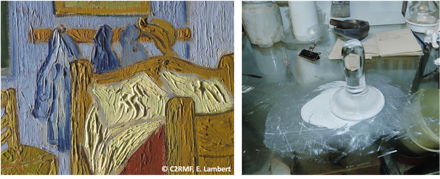For more than ten years, Guylaine Ducouret, research engineer at the SIMM laboratory (ESPCI Paris – PSL, CNRS, Sorbonne University), has been collaborating with the specialized teams of the Centre de Recherche et de Restauration des Musées de France (C2RMF) and Laboratoire d’Archéologie Moléculaire et Structurale (LAMS) to study works of art, especially paintings.
The researchers are particularly interested in the properties of the materials used by painters over the centuries : how they flow, dry, and withstand time according to their content (pigments, oil, water, binders).
Apart from these scientific questions, there are real issues like the understanding of the pictorial technique which should enable curators and restorers to safeguard this heritage.
 Picture taken from Salvant-Plisson et al 2014: (left) Detail of Van Gogh's Bedroom in Arles (© C2RMF, E. Lambert), at the Musée d'Orsay, dated 1889, illustrating the strong impastos encountered in the artist's works; (right) tool used to prepare model paints for rheological measurements.
Picture taken from Salvant-Plisson et al 2014: (left) Detail of Van Gogh's Bedroom in Arles (© C2RMF, E. Lambert), at the Musée d'Orsay, dated 1889, illustrating the strong impastos encountered in the artist's works; (right) tool used to prepare model paints for rheological measurements.
“The first project was focused on sfumato, the vaporous shapes, emblematic of Leonardo da Vinci who used this technique for the cheeks of the Mona Lisa” explained Guylaine Ducouret. Physical chemist, the researcher rediscovers with a certain thrill the same scientific questions in these heritage materials as with the contemporary industrial materials.
“A few years ago, we also collaborated on the study of the white pigments used by Vincent Van Gogh in his paintings. In fact, VG used both zinc and lead white pigments. But why two whites? This question arose from a doctoral project in the C2RMF, related to a Franco-Dutch exhibition on Van Gogh’s practices. The microscopic analysis of the pigments were completely different as the macroscopic properties! The rheological study allowed us to understand the reasons why VG used two white pigments simultaneously on the same painting: one of the pigments leads to a fluid and covering paint, used as a pictorial undercoat while the other pigment was chosen to be on the surface for its viscoelastic and impasto properties.
These analyses are crucial to the understanding of the flow properties of the paints during their application and their impact on the final aspect of the work of art.
Since the research on VG, other projects have followed: a project on the drying of varnishes in collaboration with LAMS; more recently a study on tempera paints, with egg yolk as a binder. We set out to understand how molecular interactions determine the properties of pictorial material, for example in the painting "The Madonna of Manchester" (Michelangelo, around 1497, tempera on wood, in The National Gallery London).
“There is still a gap between the vision of curators and that of scientists who can shed light on the methods used by artists” adds Guylaine Ducouret. Van Gogh, for example, noticed a certain resistance when he tapped his ultramarine blue paintings with his brush. At the time, he didn’t realize he was actually experimenting the shear-thickening nature of this very special pigment.
Thanks to these interdisciplinary collaborations, scientific research will bear fruit.
References:
Connecting rheological properties and molecular dynamics of egg-tempera paints based on egg yolk, FANOST A., DE VIGUERIE L., DUCOURET G., MERIGUET G., WALTER P., GLANVILLE H., ROLLET A-L, JABER M.
Angewandte Chemie, 24 novembre 2021. DOI : 10.1002/anie.202112108
A 19th Century "Ideal" Oil Paint Medium: A Complex Hybrid Organic-Inorganic Gel
DE VIGUERIE L., JABER M., PASCO H., LALEVEE J., MORLET-SAVARY F., DUCOURET G., RIGAUD B., POUGET T., SANCHEZ C. and WALTER P.
Angew. Chem. Inter., 56, 6, 1619-1623 (2017)
Rheology of white paints: how Van Gogh achieved his famous impasto?
SALVANT-PLISSON J., DE VIGUERIE L., TAHROUCHT L., MENU M., DUCOURET G.
Colloids and Surfaces A: Physicochemical and Engineering Aspects, 458, 134-141 (2014)
Historical evolution of oil painting media: A rheological study
DE VIGUERIE L.; DUCOURET G.; LEQUEUX F., MOUTARD-MARTIN T., WALTER P.
COMPTES RENDUS PHYSIQUE, 10 , 7, 612-621 ( 2009 )
New insights on the glaze technique through reconstruction of old glaze medium formulations
DE VIGUERIE L., DUCOURET G., COTTE M., WALTER P.
Conference: 5th International Conference on Formulation Technology Location: Potsdam,
COLLOIDS AND SURFACES A-PHYSICOCHEMICAL AND ENGINEERING ASPECTS , 331, 1-2, 119-125 (2008)







